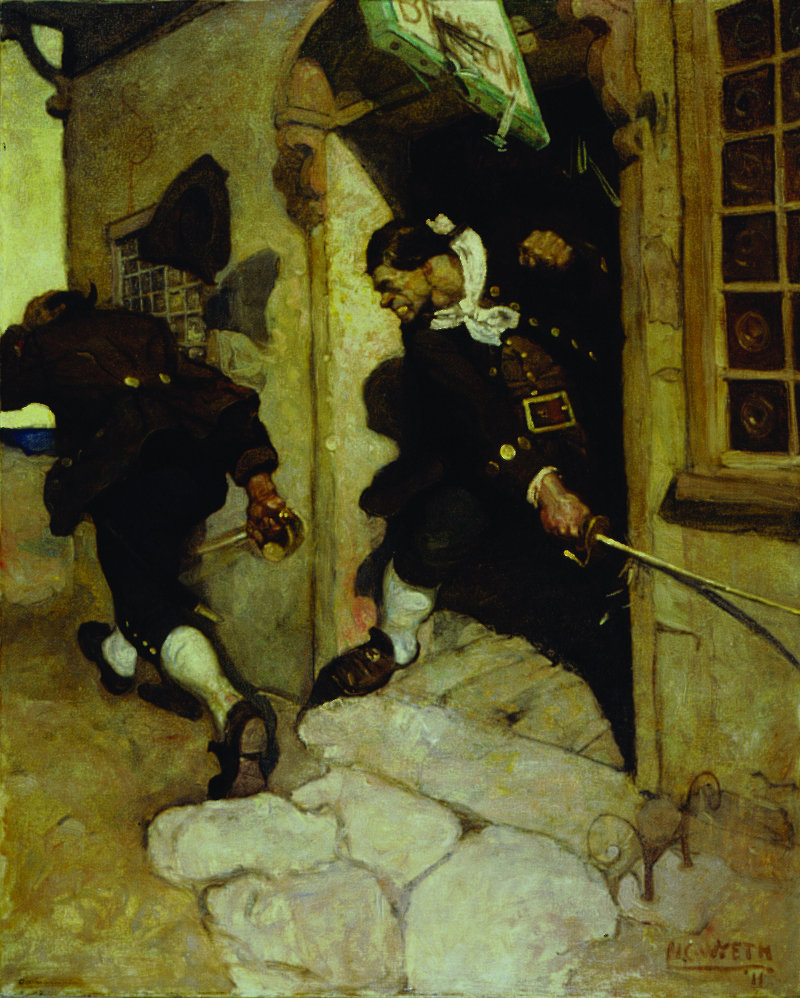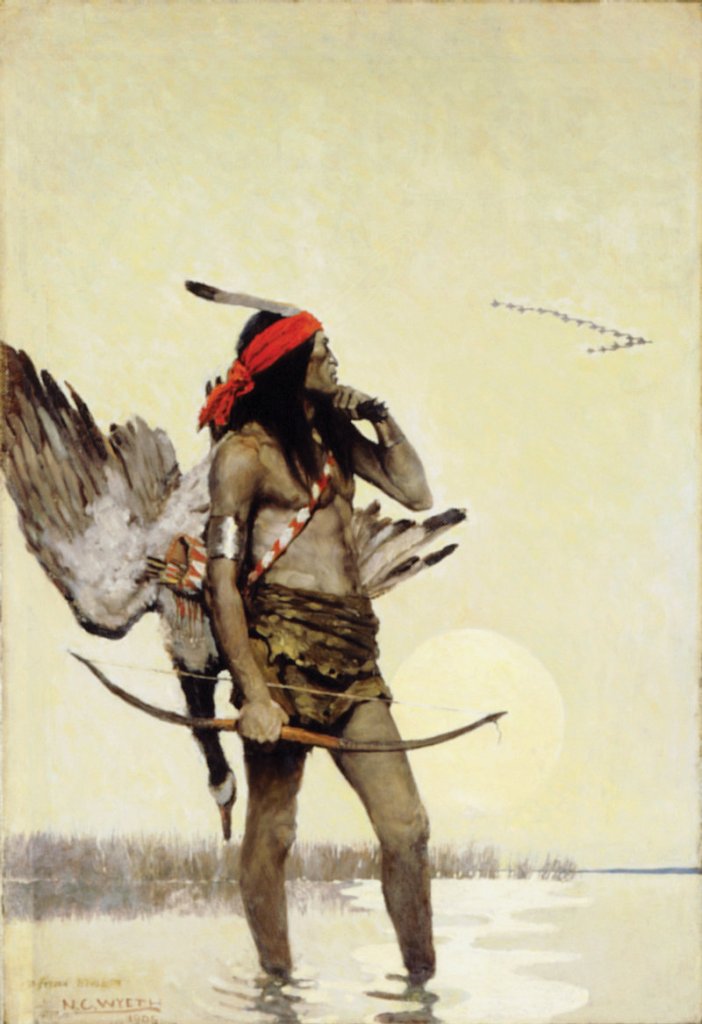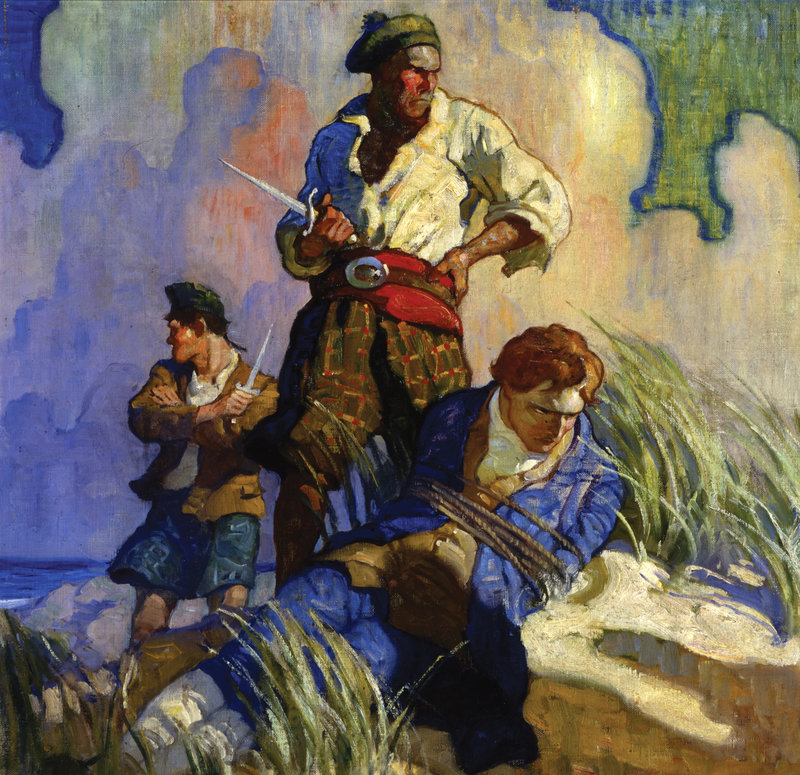ROCKLAND — My introduction to classical music was a Saturday-morning thing. Like so many American kids, I first heard — and loved — Wagner and Mozart as brought to us by Bugs Bunny.
I still listen to classical music.
My introduction to fine art came through wandering the Colby College Museum of Art and by perusing the beautifully illustrated books at my grandmother’s house. The images of Gustave Dore and N.C. Wyeth (1882-1945) in the works of Robert Louis Stevenson, Kenneth Roberts and Cervantes lit a fire inside me.
N.C. Wyeth is still one of my favorite artists.
The Farnsworth Museum of Art’s “Every Picture Tells a Story” exhibition is a strong and — because it comprises mostly works from the Brandywine River Museum in Chadds Ford, Pa. — pleasantly fresh exhibition of Wyeth’s paintings for illustrations.
This is a painting exhibition, and I see Wyeth as a painter. It’s easier to fully understand his work as paintings. He became a professional artist, after all, at a time when the standards had been set by the academic paintings that still rule the Louvre.
At the top of the academic hierarchy of genres was history painting. After that came religious painting, portraiture, landscape, genre paintings and so on. Without getting caught up in the machinations of modernism and details about the other genres, history painting, in short, was illustration.
It is a mistake to disparage history painting — as so many 20th-century artists have — and pretend it was unsophisticated “illustration.” In reality, the educated public understood the rhetoric and philology behind it, while we hardly remember what “philology” even means. (It combined linguistics, history and literary criticism, and was a subject Joshua Chamberlain — the hero of Gettysburg — taught at Bowdoin College.)
This is why we routinely underestimate N.C. Wyeth’s greatness.
Featuring dozens of paintings from the Brandywine, “Every Picture” is a big show. The works are strikingly powerful and unexpectedly dense. They are accompanied by interesting label copy that explains details about their related publications, authors, publishers, professional and technical practices, and so on.
One of the most notable works in the Farnsworth show is the painting for the cover of “David Balfour,” the sequel to Robert Louis Stevenson’s “Kidnapped.” It is a work of historical fiction (though loaded with real historical figures) set in the aftermath of the 18th-century Jacobite uprising in Scotland.
Wyeth depicts the main character as the bound captive of a pair of fearsome, dagger-armed men. We look up at the trio on a seaside dune in harsh, raking afternoon light under soaring cumulus clouds, all rendered in masterful and strikingly unexpected high-contrast color.
The right upper patch of sky is green, and the clouds are saturated with peach, purple and blue. The ruddy face of the center captor ranges from invisibly deep darks to dazzling speckles of reflected white highlight. Wyeth was a great colorist.
The scene is so exciting that we are distracted from noticing its qualities as a painting.
But these are powerful paintings executed with a bold brush. And they are big. We are reminded of this with a pair of extraordinary full-scale composition charcoal drawings.
One is a landscape-based corn harvest; the other shows men rowing a rescue dory through a violently raucous sea towards a stricken schooner. While my inclination is to focus on the ocean action, what matters most is what the drawings reveal: Wyeth could draw, and he could compose a great picture. And scale mattered to him.
We see this dedication to scale in subtle ways. We look up at the scenes like we do the giant Salon machines in the Louvre. I see Michelangelo’s heroic “David” in Wyeth’s extraordinarily iconic “The Hunter,” which shows a chiseled and breechcloth-garbed Native American brave with bow in hand and goose quarry over his shoulder as he similarly looks up at a migrating flock in V-formation.
Watching the king from “A Boy’s King Arthur” inflicting wrathful vengeance on a wayward knight, we are reminded that children weren’t hidden from violence 100 years ago — the battle takes place on a gruesome hill of armored bodies.
Yet the portrayal of violence was different in the era before television. It was psychological. In books, it’s personal drama, unlike the flossy theatricality we associate with the “action” genre. Mediated by psychology, violence is a moral issue rather than a question of style.
We see Wyeth’s psychological virtuosity in a powerful World War I propaganda image of Belleau Wood for a 1918 cover of Redbook magazine.
The aggressive American troops sweep in from the right while the panic-stricken Germans hesitate. One marine skewers his foe while the fearless moral dedication of the closest American is legible in his strong-chinned countenance. It’s not a simple cartoon; it’s complex and compelling.
Because we have forgotten the ways of rhetoric (also taught by Chamberlain), some of Wyeth’s body language is illegible to us. But, unsuspecting, we can be caught unawares.
Because of the narrative depth of the work, it’s easy to lose track of time in “Every Picture.” But there are other fascinating shows at the Farnsworth, most notably an exhibition of the work of Jonathan Fisher, a multi-talented Blue Hill minister and artist whose study and prints of biblical animals are fascinating.
Also, while we think of Van Gogh’s “Irises” as the historic big-ticket item from Maine, “Her Room” by Andrew Wyeth (son of N.C.) caused the world to notice the Farnsworth (which bought it) by selling for more than any painting ever had by a living artist in America. The creepily histrionic “Her Room” is on view with an impressive cadre of studies for it.
And I could go on — there are four other good shows on view at the museum — but for a lack of space.
Daniel Kany is a freelance writer who lives in Cumberland.
Send questions/comments to the editors.





Success. Please wait for the page to reload. If the page does not reload within 5 seconds, please refresh the page.
Enter your email and password to access comments.
Hi, to comment on stories you must . This profile is in addition to your subscription and website login.
Already have a commenting profile? .
Invalid username/password.
Please check your email to confirm and complete your registration.
Only subscribers are eligible to post comments. Please subscribe or login first for digital access. Here’s why.
Use the form below to reset your password. When you've submitted your account email, we will send an email with a reset code.